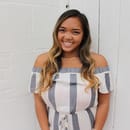Haute couture is a beautiful, extravagant word. It is admired by millions but only worn by few. The process of making such magnificent pieces is equally as beautiful as the end results seen on the runway twice a year. However, haute couture comes at a price — not only at a high financial price, but at the price of time as well.
What is Haute Couture?
Photo by Yogendra Singh via Unsplash
Before getting into the timeline of a collection, defining haute couture is important. Fashion weeks seem to be ongoing, with some sort of collection for someone coming out every few weeks, but certain runways are defined for certain types of products.
According to Wikipedia, there are four criteria that make a brand haute couture. Brands who are couture oftentimes have a ready-to-wear — or prêt-à-porter, as the french call it — line in addition to more wearable and marketable items. The four criteria include:
1.) Design made-to-order for private clients, with one or more fittings.
2.) Have a workshop (atelier) in Paris that employs at least 15 full-time staff members
3.) Must have 20, full-time technical people in at least one workshop (atelier)
4.) Every season, must present a collection of at least 50 original designs to the public, both day and evening garments, in January and July of each year
More specifically “couture is not just expensive clothing, French couture is a very specific way of producing clothing. It’s a handmade garment,” according to an expert in Netflix’s documentary 7 Days Out With Karl Lagerfeld, Chanel.
Well-known brands include Armani, Chanel, Dior, Givenchy and Versace. The entire list can be found on the list of grand couturiers.
“When you’re a couture brand it’s timeless. You don’t want it only for one season you want to maintain it,” Maria Chiuri, creative director of Dior, said in Vogue’s “How a Dior Dress Is Made, From Sketches to the Runway.”
Couture collections, “don’t show at the four big fashion weeks around the world,” said The Huff Post. They have their own shows which often take place in Paris.
The Fall/Winter Couture Fashion week was held June 30 to July 4. The Spring/Summer Couture Fashion Week will be held Jan. 20, 2020 to Jan. 23, 2020.
What is a Collection?
Another thing to be defined before getting into the creative process that proceeded runway shows is a collection. A collection structure is a complex system of pieces that is a combination of old and new products.
There are carry-over products. This is the iconic product which is signature the brand, for example, Fendi’s Fendi Baguette or Chanel’s Boy Bag. These products appear in each season’s haute couture collections, however, there is variation in the color and fabrics depending on seasonal trends.
There are also commercial products. These are the items that are most marketable and can sell. They are better known as the basics of a collection.
And there are the research products. These pieces are the exotic seasonal and trend pieces that show more often than not.
Collection Creation
Photo by Raden Prasetya on Unsplash
So how long does the process take? Fashion is always months ahead, considering the runway shows take place at least two months before the first season rolls around that the clothes presented are suitable for.
Federica Vacca, assistant professor at Politecnico di Milano in the design department, says on average it takes a designer about seven months to create a collection. That means before one collection hits the runway the other is already in the works.
The entire process from start to end looks like this.
1.) External/Internal Research on fashion trends
2.) Defining the collection guidelines
3.) Defining the collection plan
4.) Collection development
5.) Collection presentation
Research can be done in many ways. It often stems from cultures, unique societies or from past people and experiences.
When it comes to creating a collection,“it’s important to understand the past because you can better understand the present,” Chiuri said.
From research, a mood board is created filled with inspiration and sketches. A mood board tells the story of a collection and/or the theme wishing to be presented to the public.
When it comes to Chanel and their design, “Karl would sketch everything himself when he envisions them,” the documentary says. “Premieres sculpt the cloth into the dresses from the drawings.”
In terms of how long it takes, the seven months are mainly used for research, sketches, collection guidelines and planning. Design, creation and embroidery take substantially less time. The documentary says that “each outfit in the collection takes over 160 hours to make starting six weeks before the show.” The embroidery itself takes about three to four weeks.
One week prior to the show is when everything comes together.
Going off of Chanel for reference based upon the previously talked-about documentary, models arrive five days out and the outfits are selected for each model. In addition, the first fitting is done.
Two days out, the garments are shown to the designer and on the spot and adjustments are made. The film says each piece gets three seconds of evaluation to fix technical problems and from there the pieces are photographed.
On the last day before the show, there are two more fittings.
Four hours before there is a model rehearsal.
Now it’s showtime.
The countdown for the next season’s show has already begun and the process repeats. Haute couture will forever be a fast-paced, fascinating environment shaping captivating millions and worn by few.



